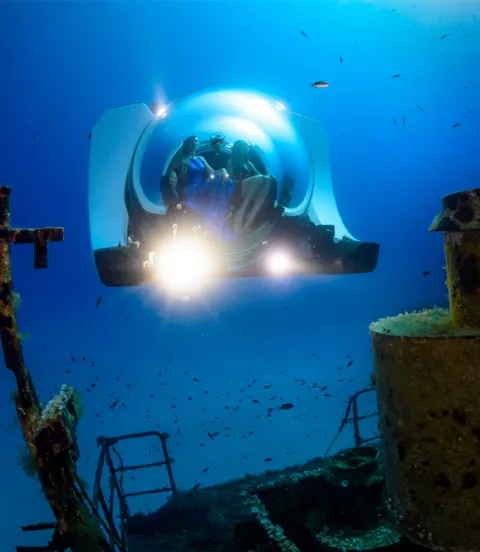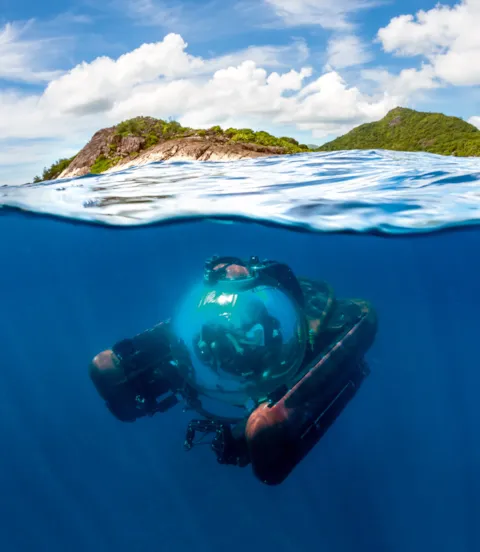Breaking the mould
With the increasing popularity of the cruise market and as superyacht owners seek the next thrill, the private submersible sector is expected to grow substantially over the next few years. CRUISE UPDATE looks at some of the latest DNV GL projects in this field.
At the U-Boat Worx production facility in the Netherlands, a group of engineers have gathered around the three-metre-long submersible Super Yacht Sub 3 for its factory acceptance test. Once it passes a visual inspection and dry tests on the propulsion, electric and hydraulic systems, the submersible is taken for harbour and sea trials. The Super Yacht Sub 3 is one of the most popular models produced by U-Boat Worx in Breda. The Dutch manufacturer specializes in submersibles for the pleasure boat and research sectors. “Our aim is to make our submersibles as safe, manoeuvrable and comfortable as possible. To ensure they meet the highest quality and safety standards, we have been cooperating closely with DNV GL for a number of years,” explains Erik Hasselman, Commercial Director at U-Boat Worx.

3,600 tonnes of pressure
“Submersibles can reach depths of up to 300 metres and open up a whole new world for cruise passengers to explore, including areas that divers cannot reach,” says Andreas Fischer, DNV GL Inspection Engineer — Pressure & Underwater Technology. “Every new model is tailor-made for the customer, and all calculations have to be made against pressure considerations to check whether the sub can withstand these kinds of depths,” he adds. At 300 metres the submersibles’ acrylic viewpoint has to resist a total force of 3,600 tonnes.
DNV GL works closely with U-Boat Worx from the design to the production phase to ensure new models achieve compliance. “Designing these subs is a challenge because we develop submersibles that can be fitted on board vessels such as superyachts. This means that the design has to be very compact while still being able to accommodate three passengers. Working with experienced staff from DNV GL has helped speed up the design process significantly,” says Stefan Franken, U-Boat Worx Manager — Classification & Quality.

Tight fit
Fitting models such as the Super Yacht Sub 3 on board a vessel requires a freeboard extender so the submersible can handle sea state three and wave heights of up to 1.5 metres. In addition, the freeboard must not be fixed permanently otherwise the craft won’t fit on the superyacht. To ensure the highest safety standards, the submersible’s 200-cell lithium-ion battery propulsion system is externally mounted and equipped with a specially developed cell monitoring system to stop the batteries from overheating or deep discharging.
The submersible has a 96-hour life support system to provide passengers with sufficient breathing air in case of an incident. The pilot also needs to press a so-called “dead man’s handle” every ten minutes otherwise an alarm system is triggered, which immediately takes the submersible safely back to the surface. As an additional safety feature, the submersible can also be operated remotely from the support vessel.

The Crystal Esprit makeover
One of the manufacturer’s recent projects for the Los Angeles-based company Crystal Cruises, owned by the Genting Group, presented both the U-Boat Worx team and DNV GL classification experts with a particular challenge: fitting a C-Explorer 3 submersible on the seasoned cruise ship Crystal Esprit. “The C-Explorer 3 was part of a larger upgrade programme for the Crystal Esprit. The main tasks were to prepare the foundations for the sub and fit the retractable telescopic crane and the ‘access hatch’ where passengers board the sub,” explains Jamel Eddine Barhoumi, DNV GL Principal Surveyor and Lead Auditor, who worked on the Crystal Esprit project at the Sembawang Shipyard in Singapore.
“Making space for the submersible was a challenge and required precise measurements. Quite a few things had to be relocated, for example ventilation ducts and mooring bollards, and pipes had to be rerouted,” he adds. DNV GL also worked closely with the superintendent regarding the lifting procedures for the six-tonne submersible. After about three months, the C-Explorer 3 was lifted and stowed on board Crystal Esprit in Penang, Malaysia, and officially launched and tried out in the Seychelles.
The classification society has worked with the owners for more than 20 years. “We know each other’s teams very well, there is very good cooperation from top management to the surveyors in the field,” says Barhoumi. According to Captain Gustaf Gronberg, SVP Marine Operations & Newbuilding for Genting and one of the group’s five certified submersible pilots, C-Explorer 3 was received very well on the Crystal Esprit. “The sub has been in operation for more than a year, and we have taken her to the Seychelles and to Croatia. Often people imagine a cigar-shaped submarine with a tiny window, but this model gives an incredible 360-degree view.” Crystal Esprit has been a success story for U-Boat Worx’s production team as well. The Genting Group has ordered four more submersibles from the Dutch manufacturer.

Biggest cruise ship with submersibles on board
U-Boat Worx has gone on to produce and install two submersibles on the recently delivered cruise vessel Genting Dream. The Asian luxury cruise liner can carry 3,348 passengers and is the biggest cruise ship to be equipped with submersibles. “In this case, we faced none of the usual space constrictions. So from a technical standpoint, the installation of the submersibles was relatively straightforward,” says Erik Hasselman from U-Boat Worx. The two C-Explorer 5 submersibles will be able to carry four passengers and a pilot and dive up to 200 metres under the surface. “They are deployed using a crane, which swings the submersible over board and lowers it 21 metres down to the ocean’s surface. This is an unmanned operation, of course, passengers board the submersible from a tender boat,” adds Hasselman.

New concepts, ambitious plans
Deployed during anchoring periods at sea, the submersibles can embark upon up to eight dives a day. They are powered by four 130 VDC battery packs (31.2 kWh) and have a typical underwater cruising speed of three knots.
Meanwhile, U-Boat Worx is working on several new concepts, including a seven and a nine-seater as well as a faster sports submersible. DNV GL will continue to support U-Boat Worx in its ambitious plans and ensure new ideas can be taken from the concept to the manufacturing stage as smoothly as possible.